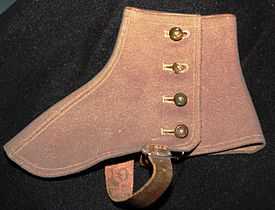Spats (footwear)


Spats, a shortening of spatterdashes, or spatter guards are a type of classic footwear accessory for outdoor wear, covering the instep and the ankle. Spats should not be confused with gaiters, which are garments worn over the shoe and lower pants leg, and used primarily as personal protective equipment.
Civilian dress
Spats were primarily worn by men, and less commonly by women, in the late 19th and early 20th centuries. They fell out of frequent usage during the 1920s. Made of white cloth or brown felt material, spats buttoned around the ankle. Their intended practical purpose was to protect shoes and socks from mud or rain but this footwear also served as a feature of stylish dress in accordance with the fashions of the period.[1]
Military uniform
French infantry wore white spats for parade and off duty wear until 1903. Italian soldiers wore a light tan version until 1910 and the Japanese Army wore long white spats or gaiters during the Russo-Japanese War of 1905.
Spats continue as a distinctive feature of the Scottish dress of Highland pipe bands, whether civilian or military. The modern Royal Regiment of Scotland, into which all Scottish line infantry regiments were amalgamated in 2006, retain white spats as part of their uniform. Prior to that date most Scottish infantry units in the British Army wore spats. For Highland regiments in kilts, spats reached halfway up the calf. For Lowland regiments in trews, spats were visible only over the brogue shoes.
Most regiments of the modern Indian and Pakistani Armies wear long white spats into which trousers are tucked, as part of their parade dress. Other full dress uniforms which still include spats are those of the Finnish Army, Swedish Army, Portuguese Republican National Guard, the Carabiniers of Monaco, the Egyptian Military Police and the Italian Military Academy of Modena. In the Finnish Navy, spats are part of the winter uniform. The U.S. Navy Honor Guard and Rifle Guard wear them while performing ceremonies.
Spats are still used as a traditional accessory in many marching band and drum and bugle corps uniforms in the United States.
Safety and protection
Spats are still used today in certain industries for safety reasons. In foundries molten metal pourers often wear leather spats to keep splashes of molten metal from burning their feet. Even a small splash that lodges in a shoe or between the shoe and ankle could cause a severe burn. Many welders also wear leather spats for protection from sparks and metal splash. Some chainsaw operators wear protective leather spats, often combined with chainsaw boots to prevent injury from accidental chainsaw contact with the foot or ankle.
Spats are also used for extreme weather conditions and are usually made from Goretex materials (See Gaiters). The Argentine Army use brown leather spats laced over combat boots as ankle supports for parachute jumping.
Symbolic usage to represent wealth
The wearing of spats is often used as symbolic shorthand to represent wealth, eccentricity or both. Fictional characters such as Agatha Christie's Hercule Poirot, P. G. Wodehouse's Bertie Wooster, Walt Disney's Scrooge McDuck, Who Framed Roger Rabbit's Toon Patrol chief weasel Smart Ass, Jean de Brunhoff's Babar the Elephant, Jiggs from the comic strip Jiggs and Maggie, Mr. Peanut, Rich Uncle Pennybags the iconic man from the Monopoly board game, the Sixth Doctor from Doctor Who and Bustopher Jones from Old Possum's Book of Practical Cats by T. S. Eliot, among others, have been depicted as wearing spats. In Some Like It Hot, the mob boss is called "Spats" Colombo, because he regularly wears spats. In some cases, these depictions occur long after spats ceased to be a normal part of everyday menswear: for instance The Penguin from Batman is drawn wearing spats along with a suit with tails. Similarly, Irving Berlin's song "Puttin' on the Ritz" mentions spats along with a variety of other elements of formal clothing that were common when it was written.
Other uses
- By extension, the phrase "spatted" refers to aerodynamic fairings around the wheels on aircraft undercarriage.
- In Japan, the term "spats" refers to leggings.
- In American football, the act of taping the outside of one's cleats using athletic tape is known as "spatting."
See also
- Gaiters
- Spatterdash (disambiguation)
References
Notes
- ↑ Article Pity the fellow who can't afford spats, page 35 "The Oldie" September 2012
External links
 Media related to Spats at Wikimedia Commons
Media related to Spats at Wikimedia Commons- actor Holmes Herbert wearing spats in a silent movie, The Divorcee with Ethel Barrymore circa 1919